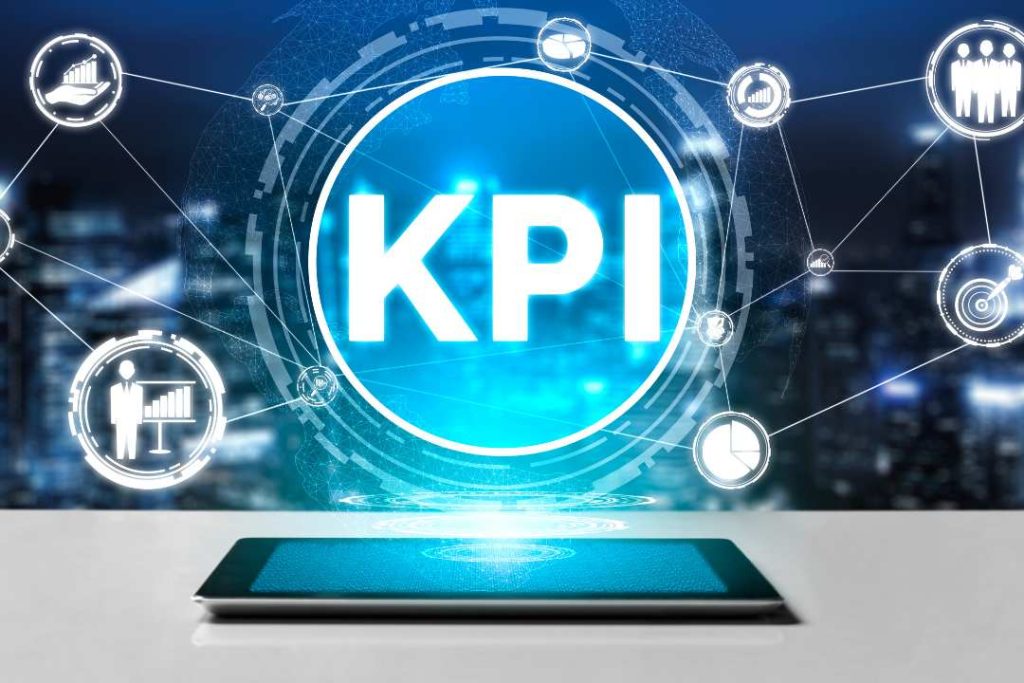In today’s data-driven business environment, 73% of companies that use KPIs effectively report achieving their strategic goals, compared to just 43% of those that don’t track performance metrics systematically. Whether you’re a startup founder, department manager, or C-suite executive, understanding and implementing the right Key Performance Indicators can be the difference between business success and failure.
This comprehensive guide will walk you through everything you need to know about KPIs: what they are, why they matter, how to choose the right ones for your business, and most importantly, how to measure and act on them to drive real results.
What is a KPI? – Understanding Key Performance Indicators
A Key Performance Indicator (KPI) is a quantifiable measure that evaluates how effectively an organization, team, or individual is achieving key business objectives. Think of KPIs as your business compass; they show you whether you’re heading in the right direction and how quickly you’re getting there.
Breaking Down the Term
- Key: The most important metrics that directly impact your success
- Performance: How well you’re executing against your goals
- Indicator: A signal that reveals progress or lack thereof
The Purpose of KPIs in Business
KPIs serve several critical functions:
- Strategic Alignment: They connect daily activities to long-term business objectives
- Performance Measurement: They provide objective ways to assess success
- Decision Making: They offer data-driven insights for better choices
- Motivation: They create clear targets for teams and individuals
- Accountability: They establish measurable standards for performance
Characteristics of Effective KPIs
Not all metrics qualify as good KPIs. Effective KPIs follow the SMART criteria:
- Specific: Clearly defined and unambiguous
- Measurable: Quantifiable with reliable data
- Achievable: Realistic and attainable
- Relevant: Aligned with business objectives
- Time-bound: Have specific timeframes for evaluation
KPIs vs. Metrics: Understanding the Difference
While often used interchangeably, KPIs and metrics are distinct:
- Metrics are any quantifiable data points (website visitors, emails sent, calls made)
- KPIs are the most important metrics that directly relate to strategic objectives
For example, “total website traffic” is a metric, but “conversion rate from organic traffic” might be a KPI if your goal is to increase qualified leads through SEO.

What is KPI in Business? – The Strategic Context
In the business context, KPIs function as the vital signs of your organization. Just as doctors monitor heart rate, blood pressure, and temperature to assess health, businesses use KPIs to monitor financial health, operational efficiency, customer satisfaction, and growth trajectory.
Business Applications Across Departments
KPIs aren’t limited to senior management or finance teams. Every department benefits from tracking relevant performance indicators:
- Sales teams track revenue metrics and pipeline health
- Marketing departments measure campaign effectiveness and lead quality
- Operations focus on efficiency and quality metrics
- HR monitors employee satisfaction and productivity
- Customer service tracks satisfaction and resolution times
Strategic Alignment Through KPIs
The most powerful KPIs create a cascade effect throughout the organization. Company-level strategic KPIs break down into departmental KPIs, which further divide into team and individual metrics. This alignment ensures everyone understands how their work contributes to broader business success.
The Decision-Making Role of KPIs
Effective KPIs transform decision-making from gut-feeling to data-driven processes. They help leaders:
- Identify which strategies are working
- Spot problems before they become critical
- Allocate resources more effectively
- Set realistic targets and expectations
- Communicate progress to stakeholders
ROI Impact of Proper KPI Implementation
Companies with mature KPI programs typically see:
- 20% improvement in operational efficiency
- 15% increase in revenue growth
- 25% reduction in time spent on reporting
- 30% better alignment between departments
The 5 Essential Types of KPIs
Understanding different KPI categories helps you build a balanced scorecard that provides a 360-degree view of your business performance. Here are the five essential types every business should consider:
1. Financial KPIs
Financial KPIs measure the monetary health and performance of your business. They’re typically lagging indicators that show results of past activities.
Key Examples:
- Revenue Growth Rate: Measures how quickly your income is increasing
- Gross Profit Margin: Shows profitability after direct costs
- Return on Investment (ROI): Evaluates the efficiency of investments
These metrics are crucial for investors, stakeholders, and long-term strategic planning.
2. Customer KPIs
Customer KPIs focus on how well you’re serving your market and building lasting relationships.
Key Examples:
- Customer Satisfaction Score (CSAT): Measures immediate satisfaction with products/services
- Customer Retention Rate: Tracks how many customers continue doing business with you
- Customer Lifetime Value (CLV): Calculates total revenue expected from a customer relationship
Customer KPIs often predict future financial performance and help prioritize customer experience investments.
3. Process KPIs
Process KPIs evaluate the efficiency and effectiveness of your internal operations.
Key Examples:
- Operational Efficiency Ratio: Compares output to input resources
- Quality Defect Rate: Measures product or service quality standards
- On-time Delivery Rate: Tracks reliability in meeting commitments
These metrics help identify bottlenecks and optimization opportunities.
4. People KPIs
People KPIs focus on your most valuable asset: your employees and their performance.
Key Examples:
- Employee Engagement Score: Measures workforce motivation and satisfaction
- Productivity per Employee: Calculates output relative to headcount
- Employee Turnover Rate: Tracks retention and hiring effectiveness
Strong people KPIs often correlate with better performance in all other areas.
5. Growth KPIs
Growth KPIs measure your expansion and market position, often serving as leading indicators of future success.
Key Examples:
- Market Share Percentage: Shows your position relative to competitors
- New Customer Acquisition Rate: Measures expansion of your customer base
- Revenue from New Products: Tracks innovation success
These metrics help assess long-term viability and competitive positioning.
25+ KPI Examples by Department
Here’s an overview of essential KPIs organized by business function. Each department has unique metrics that align with their specific objectives while contributing to overall business success.
Sales KPIs
Sales KPIs track revenue generation and pipeline health:
- Monthly Recurring Revenue (MRR): Predictable revenue stream measurement
- Sales Conversion Rate: Percentage of prospects that become customers
- Average Deal Size: Mean value of closed deals
- Sales Cycle Length: Time from first contact to closed deal
- Pipeline Velocity: Speed at which deals move through sales stages
For comprehensive sales KPI strategies and industry benchmarks, explore our detailed Sales KPIs Guide.
Marketing KPIs
Marketing KPIs measure campaign effectiveness and lead generation:
- Cost Per Acquisition (CPA): Investment required to gain one customer
- Marketing Qualified Leads (MQL): Number of prospects ready for sales engagement
- Return on Ad Spend (ROAS): Revenue generated per marketing dollar spent
- Email Open Rate: Engagement with email marketing campaigns
- Organic Traffic Growth: Improvement in unpaid website visitors
Dive deeper into marketing performance measurement with our Marketing KPIs Handbook.
Operations KPIs
Operations KPIs focus on efficiency and quality:
- Overall Equipment Effectiveness (OEE): Manufacturing efficiency metric
- Inventory Turnover Rate: How quickly inventory converts to sales
- Order Fulfillment Accuracy: Percentage of orders shipped correctly
- Supplier Performance Score: Vendor reliability and quality assessment
- Waste Reduction Percentage: Efficiency in resource utilization
Learn more about operational excellence metrics in our Operations KPIs Guide.
HR KPIs
HR KPIs measure workforce effectiveness and satisfaction:
- Time to Hire: Duration from job posting to offer acceptance
- Employee Net Promoter Score (eNPS): Likelihood of employees recommending the company
- Training Completion Rate: Percentage of required training completed
- Absenteeism Rate: Frequency of unplanned employee absences
- Internal Promotion Rate: Percentage of roles filled by existing employees
Explore comprehensive workforce metrics in our HR KPIs Complete Guide.
Customer Service KPIs
Customer service KPIs track support effectiveness and customer satisfaction:
- First Call Resolution Rate: Percentage of issues resolved on initial contact
- Average Response Time: Speed of initial customer service response
- Net Promoter Score (NPS): Customer loyalty and advocacy measurement
- Customer Effort Score (CES): Ease of getting issues resolved
- Support Ticket Volume: Number of customer service requests
Master customer experience measurement with our Customer Service KPIs Manual.
Financial KPIs
Financial KPIs provide insight into fiscal health:
- Cash Flow: Net amount of cash moving in and out of business
- Accounts Receivable Turnover: Efficiency of collecting payments
- Debt-to-Equity Ratio: Financial leverage and risk assessment
- Working Capital: Short-term financial health indicator
- Profit Margin by Product Line: Profitability analysis by offering
Get detailed financial performance insights in our Financial KPIs Masterclass.
How to Measure Key Performance Indicators
Measuring KPIs effectively requires a structured approach that ensures accuracy, relevance, and actionability. Here’s a comprehensive framework for KPI measurement success.
Step 1: Define Your Objectives
Before selecting any KPIs, clearly articulate what you want to achieve. Start with your organization’s mission and strategic goals, then work backward to identify the metrics that best indicate progress toward those objectives.
Best Practices:
- Use the SMART criteria for goal setting
- Align KPIs with specific business outcomes
- Involve stakeholders in objective-setting discussions
- Document the connection between KPIs and strategic goals
Step 2: Choose the Right KPIs
Not every metric deserves KPI status. Focus on indicators that directly influence your ability to achieve strategic objectives.
Selection Criteria:
- Relevance: Does this metric directly relate to your goals?
- Actionability: Can you take specific actions based on this metric?
- Clarity: Is the metric easy to understand and interpret?
- Reliability: Can you consistently collect accurate data?
Avoid Common Pitfalls:
- Vanity metrics that look impressive but don’t drive decisions
- Metrics that are too complex to understand or act upon
- KPIs that encourage gaming or counterproductive behavior
Step 3: Establish Baselines and Targets
Understanding where you currently stand provides context for measuring improvement.
Baseline Development:
- Analyze historical performance data
- Research industry benchmarks and standards
- Consider seasonal variations and trends
- Account for any recent changes in business conditions
Target Setting:
- Set stretch goals that motivate without being unrealistic
- Consider both short-term milestones and long-term objectives
- Build in regular review points to adjust targets as needed
- Communicate targets clearly across the organization
Step 4: Select Measurement Tools and Technology
The right tools make KPI tracking efficient and accurate.
Technology Options:
- Business Intelligence Platforms: Comprehensive analytics solutions (Tableau, Power BI)
- Specialized KPI Dashboards: Purpose-built tracking tools (Klipfolio, Geckoboard)
- Integration Tools: Connect multiple data sources (Zapier, Microsoft Power Automate)
- Custom Solutions: Built specifically for your unique needs
Tool Selection Criteria:
- Data source compatibility
- Real-time reporting capabilities
- User-friendly interface
- Scalability for future growth
- Cost-effectiveness
Step 5: Create a Measurement Framework
Establish consistent processes for data collection, analysis, and reporting.
Framework Components:
Data Collection:
- Identify data sources and collection methods
- Establish data quality standards
- Create backup and validation procedures
- Assign data collection responsibilities
Reporting Structure:
- Determine reporting frequency (daily, weekly, monthly, quarterly)
- Design dashboard layouts and visual presentations
- Create different report versions for different audiences
- Establish data security and access controls
Analysis Process:
- Define standard analysis procedures
- Create templates for variance analysis
- Establish root cause analysis protocols
- Set up alert systems for significant deviations
Step 6: Monitor, Review, and Adjust
KPI measurement is an iterative process that requires continuous refinement.
Regular Review Activities:
- Weekly Reviews: Tactical adjustments and immediate issue identification
- Monthly Reviews: Performance trend analysis and short-term planning
- Quarterly Reviews: Strategic assessment and KPI relevance evaluation
- Annual Reviews: Comprehensive KPI framework assessment
Adjustment Triggers:
- Significant changes in business strategy
- New market conditions or competitive landscape
- Technology improvements or system changes
- Consistent over- or under-performance against targets
Continuous Improvement:
- Gather feedback from KPI users
- Test new measurement approaches
- Benchmark against industry leaders
- Invest in training and capability development
Common KPI Mistakes to Avoid
Even well-intentioned organizations can undermine their KPI programs through common pitfalls. Here are the most frequent mistakes and how to avoid them:
Measuring Too Many KPIs
The most common mistake organizations make is trying to track everything, creating information overload that ultimately reduces focus on what truly matters. When teams are asked to monitor dozens of metrics, they often lose sight of the most critical indicators and spend more time collecting data than acting on insights. The solution lies in following the “Rule of 7”, limiting yourself to 5-7 core KPIs per department or business unit. This constraint forces you to identify only those metrics that directly drive decision-making and strategic progress.
Choosing Irrelevant Metrics
Many organizations select KPIs based on what’s easy to measure rather than what’s strategically important, leading to a disconnect between daily activities and business objectives. This happens when teams choose metrics based on available data sources rather than starting with desired outcomes. The solution requires always beginning with business objectives first, then identifying the metrics that best indicate progress toward those goals, even if the data collection requires additional effort or investment.
Setting Unrealistic Targets
Target setting often goes wrong in two directions: targets that are too aggressive demotivate teams and create a culture of failure, while targets that are too easy don’t drive meaningful improvement or growth. Both extremes undermine the motivational power of KPIs. Effective target setting uses historical data, industry benchmarks, and stakeholder input to establish challenging but achievable goals that stretch performance without breaking morale.
Ignoring Data Quality Issues
Poor data quality represents one of the most destructive forces in KPI programs, leading to incorrect conclusions and misguided actions that can damage business performance. When teams lose trust in their metrics due to inconsistent or inaccurate data, they revert to intuition-based decision making. Success requires investing in data validation processes, conducting regular audits, and establishing clear data governance policies that ensure reliable information flows through your measurement systems.
Lack of Actionable Insights
The final common mistake involves collecting data without connecting it to specific actions or decisions, turning KPI dashboards into expensive information displays rather than decision-making tools. For every KPI in your system, you should be able to clearly define what actions will be taken when performance is above target, at target, or below expectations. This action orientation transforms metrics from passive reporting into active management tools.
KPI Best Practices & Implementation Tips
Success with KPIs requires more than just selecting the right metrics. Here are proven practices for maximizing the impact of your KPI program:
Limit Your Focus
Quality over Quantity: It’s better to deeply understand and act on 5-7 critical KPIs than to superficially monitor 20+ metrics. Focus creates clarity and drives action.
Ensure Data Accuracy and Consistency
Single Source of Truth: Establish clear data definitions and sources to prevent conflicting reports. When everyone uses the same calculation methods and data sources, you eliminate confusion and build trust in your metrics.
Make KPIs Visible and Accessible
Transparency Drives Performance: Use dashboards, regular reports, and visual displays to keep KPIs front and center. When people can easily see current performance, they’re more likely to take action to improve it.
Democratize Data Access: Don’t limit KPI access to senior management. Give teams and individuals access to their relevant metrics so they can self-manage and improve performance.
Establish Regular Review Rhythms
Consistent Cadence: Create predictable schedules for reviewing KPIs at different levels:
- Daily operational reviews for time-sensitive metrics
- Weekly team performance discussions
- Monthly departmental assessments
- Quarterly strategic reviews
Link KPIs to Incentives Appropriately
Alignment Without Gaming: Connect KPIs to recognition and compensation systems, but be careful to avoid unintended consequences. Consider using balanced scorecards rather than single-metric incentives.
Foster a Data-Driven Culture
Education and Training: Invest in helping your team understand not just what the numbers mean, but how to interpret trends, identify root causes, and take appropriate action.
Celebrate Improvements: Recognize when teams use KPI insights to drive positive changes, even if the ultimate outcome isn’t perfect.
Conclusion & Next Steps
This comprehensive guide has explored what KPI are, provided numerous KPI examples, explained the KPI meaning in business contexts, and detailed how to measure key performance indicators effectively. By understanding what are the 5 key performance indicators and implementing the measurement framework outlined here, you’re setting your organization up for sustained success.
Remember these key takeaways:
- Start with clear objectives before selecting KPIs
- Focus on quality over quantity in your metric selection
- Establish robust measurement processes and technology
- Create a culture that values data-driven insights
- Regularly review and refine your KPI program
Your Next Steps:
- Audit Your Current Metrics: Evaluate which of your existing measurements truly qualify as KPIs
- Identify Gaps: Determine where you need better visibility into performance
- Choose Your Focus: Select 5-7 core KPIs that align with your most important objectives
- Implement Measurement Systems: Set up the tools and processes needed for consistent tracking
- Start Small: Begin with one department or business unit before expanding organization-wide
The journey to effective KPI implementation isn’t always straightforward, but the benefits, better decisions, improved performance, and accelerated growth, make the investment worthwhile. Start today with one well-chosen KPI, and build your capability from there.
Success in today’s competitive business environment requires more than intuition and experience. It demands the clarity and focus that only well-implemented KPIs can provide. Take the first step toward data-driven success by putting these insights into action.



